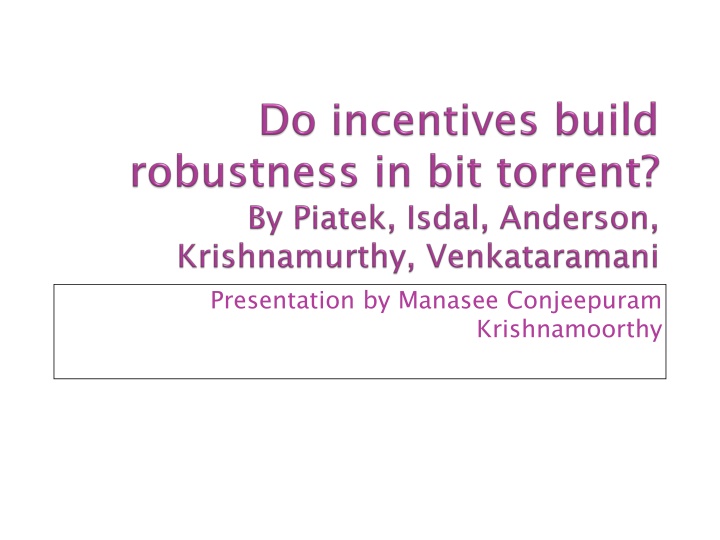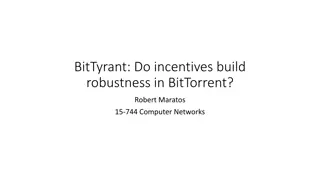
BitTorrent: Altruism, Incentives, and File Transfer Process
Delve into the world of BitTorrent with insights on altruism, incentive mechanisms, and the file transfer process. Explore how BitTyrant addresses free-riding issues, the strategic benefits of modified clients, and the dynamics of peer interactions in this peer-to-peer system.
Download Presentation

Please find below an Image/Link to download the presentation.
The content on the website is provided AS IS for your information and personal use only. It may not be sold, licensed, or shared on other websites without obtaining consent from the author. If you encounter any issues during the download, it is possible that the publisher has removed the file from their server.
You are allowed to download the files provided on this website for personal or commercial use, subject to the condition that they are used lawfully. All files are the property of their respective owners.
The content on the website is provided AS IS for your information and personal use only. It may not be sold, licensed, or shared on other websites without obtaining consent from the author.
E N D
Presentation Transcript
Presentation by Manasee Conjeepuram Krishnamoorthy
Main idea Introduction Bit Torrent Overview Modeling Altruism in BitTorrent Building BitTyrant Evaluation Related Work Conclusion
Fundamental problem of peer-to-peer systems free riding BitTorrent was designed to address this using TFT reciprocity and provide positive incentives for nodes that contribute Though BitTorrent is successful incentive mechanism is not robust to strategic clients Implementation of BitTyrant to solve this
A modified BitTorrent client designed to benefit strategic peers Key Idea - Carefully select peers and contribution rates Robustness requires that performance does not degrade Discover the presence of significant altruism in BitTorrent Unnecessary contributions that can be reallocated to improve performance for strategic clients
How file transfer happens Peers download a metadata file called torrent Metadata file specifies the name, size of the file, address of the tracker server Tracker Server coordinates interactions amongst peers Peers contact the tracker upon startup, departure and when download is in progress Seeds Users in possession of the complete file Local Neighborhood Set of directly connected peers Each peer transmits messages indicating the blocks they currently possess and signal their interest in the blocks of other peers
Active Set Set of peers to which a BitTorrent client is currently sending data Unchoked Peers Peers from which one peer has received data rapidly in the recent past Optimistically Unchoked Peers Randomly chosen peers
Choked Peers Peers that do not send data quick enough and removed from the active set Equal Split Rate Each peer provides an equal share of its upload capacity to peers in its active set Active set size upload capacity
How much altruism is present? What are the sources of altruism? Assumptions to model altruism Representative distribution Uniform sizing No steady state High block availability
Representative distribution The distribution of the bandwidth capacity of IP addresses in a swarm is not identical over many swarms. High capacity peers Finish quickly and join more swarms Results in increase of low capacity peers.
Uniform sizing Aggressive active set sizes reduce altruism Our model provides a conservative estimate of altruism Implementation Percentage share Azureus BitComet torrent BitLord Unknown Reference Remaining BitTorrent implementation usage as drawn from measurement data. 47% 20% 15% 6% 3% 2% 7%
No Steady state If churn is low, over time TFT may match peers with similar equal split rates, biasing active set draws High Block Availability Peers always need interesting data to download Static active set sizing may degrade block availability for high capacity peers
Reference bit torrent optimistically unchokes two peers every 30 seconds Expectation * Active set = Time taken for a new peer to wait before filling its active set
For a peer with 6000 KB/s upload capacity, it takes about 670 seconds to reach steady state ( 4 GB of data transmitted) High capacity clients are forced to peer with those of low capacity
Reciprocation from peer Q to peer P is determined by 2 factors Rate at which P sends data to Q Rate at which other peers send data to Q
Equal split capacity = 16 KB/s while reciprocation is 1.0 Equal split capacity = 11 KB/s while reciprocation is 0.6 Reciprocation probability for a peer as a function of raw upload capacity as well as reference BitTorrent equal split bandwidth Equal split rate >14KB/s reciprocation is assured Further contribution may be altruistic To 29 To 29
A peer P receives data from TFT reciprocation Optimistic Unchokes Number of optimistic unchokes is 2 Each peer unchokes 2 peers and also receives two optimistic unchokes
Expectation of download performance as a function of upload capacity Sub-linear growth suggests significant unfairness in bit torrent Unfairness improves performance for low capacity peers High capacity peers can better allocate upload capacity to improve performance
Two factors control the upload rate of a peer Data availability Capacity limit Limited data availability Peer does not have enough data of interest Upload capacity is wasted and utilization suffers It is crucial that client downloads new data, so it can redistribute and saturate upload capacity
This is the case in reference bit torrent client because of its square root growth rate of active set In practice active set is a static parameter but NOT dynamic Azureus, a bit torrent client suggests an active set size of 4
We consider two definitions of altruism Altruism = Expected Upload rate download rate Any upload contribution that can be withdrawn without loss in download performance
Expected percentage of upload capacity which is altruistic (w.r.t def 1 Altruism = Expected upload rate Download rate Reflects the asymmetry of upload contribution Only when upload capacity > 100 KB/s we have altruism
Expected percentage of upload capacity that is altruistic - upload capacity not resulting in direct reciprocation High capacity peers send data much faster than that required for minimal reciprocation Low capacity peers despite not being reciprocated - still receive data faster than they send Receive indiscriminate optimistic unchokes in spite of low upload capacity
The relationship between download throughput and upload is not linear Each time a bit torrent client receives a complete data block from another peer it broadcasts a have message Now, it can redistribute this block to other peers We average the rate of have messages over the duration our measurement client observes a peer
Measured validation of sub-linear growth in download throughput as a function of rate These results indicate an even higher level of altruism than that predicted by our model Peers contributing 250KB/s had a download rate of 150KB/s In our model, the download rate was 200KB/s for the same upload capacity This is due to more conservative set sizes in practice
We base bit tyrant on the Azureus client as it is most popular As contribution increases, performance improves, but not in direct proportion Performance of low capacity peers is disproportionately high Strategic user can exploit this unfairness by masquerading many low capacity clients to improve performance
We focus on bit torrents robustness to strategic behavior Focus on improving performance in isolation while promoting fairness at scale Maximizing reciprocation Maximize reciprocation bandwidth per connection Maximize number of reciprocating peers Deviate from equal split
Maximize reciprocation BW per connection Find peers that reciprocate with high band width for a low offered rate Reciprocation bandwidth is dependent on its upload capacity and active set size By identifying peers that have large reciprocation bandwidth - a client can optimize for a higher reciprocation BW per connection
Maximize number of reciprocating peers A client can add to its active set size until its performance is not detrimentally affected Deviate from equal split A client can reduce its upload contribution to a particular peer as long as it continues to reciprocate The bandwidth savings can then be reallocated
Largest source of altruism unnecessary contribution to peers in active set The reciprocation behavior points to a performance trade-off Increase in active set size reduces equal split rate, hence reducing reciprocation probability 15 15
The expected download performance of a client with 300KB/s upload capacity for increasing active set size Maximum download rate 450 KB/s Active set size > 25, sharp downfall of download rate
Assumptions and Characteristics The download benefit (dp) and upload cost (up) are not known a priori. The update operation dynamically estimates these rates BitTyrant continues to unchoke peers until it exhausts its upload capacity. User-defined priorities can be implemented by using scaling weights for the dp/up ratios across multiple swarms
Determine upload contributions In our implementation, up is typically decreased by = 10%, if the peer reciprocates for r = 3 rounds Increase by 20% if the peer fails to reciprocate after being unchoked in previous round
Estimating reciprocation bandwidths We consider the average download rate over a TFT round Determine the rate of have signals from a peer Use this as the total upload capacity of the peer From Azureus, determine the active set size for this upload rate Using this determine the equal split rate and use as dp
The active set is sized to provide a diverse set of data to enable data exchange without any data availability constraints Extract more peers using Gossip among peers . The bit Torrent protocol extension is push based As the size of the local neighborhood increases the protocol overhead also increases. Increases from 0.9% to 1.9% of total file data received.
Exploiting optimistic unchokes If a peer has built up a deficit in the number of traded bytes it is less likely to be picked for optimistic unchokes Cheating client disconnect and reconnect with different client identifiers Can be prevented by maintaining IP addresses and peer statistics across disconnections
Downloading from seeds Seeds upload to peers that are the fastest downloaders Falsify download rates by emitting have messages Perform random unchokes to spread the data uniformly Falsifying block availability Peers appear to be more attractive by falsifying block announcement to increase unchoking Not very effective client can stop transferring once peer does not satisfy block requests.
Evaluate BitTyrant on real swarms drawn from popular aggregation sites to measure performance for a SINGLE strategic client Evaluate sensitivity to various upload rates and measure performance for many BitTyrant peers
CDF of download performance for 114 real world swarms Shown ratio between download times for an existing Azureus client and BitTyrant Median performance gain for BitTyrant factor of 1.72 Expect relative performance gains to be greater for clients with greater upload capacity
Download times and sample standard deviation comparing performance of a single bit tyrant client and an unmodified Azureus client Shown download performance for a single BitTyrant client as a function of rate averaged over six trials BitTyrant - improves performance and provides consistent performance across multiple trials This consistency allows peers to detect and reallocate excess capacity for other uses Azureus spread of download times over six trials is more; prediction hard
Consider two types of peers strategic and selfish Any peer that uses BitTyrant unchoking algorithm is strategic If such a peer withholds contributing excess capacity that does not improve performance it is strategic and selfish
CDFs of completion times for a 350 node planet lab experiment BitTyrant and the original unmodified client assume all users contribute all of their capacity Capped BitTyrant shows performance when high capacity selfish peers limit their contribution If peers reallocate aggregate capacity and average performance are reduced for low capacity peers
Impact of selfish BitTyrant caps on performance Download times at all bandwidth levels increase Beyond a certain point peers that contribute significantly more data (high capacity peers)do not see faster download rates
Work done in this paper differs from existing work in two ways Refute BitTorrent s incentive mechanism makes it robust Methodology Explore BitTorrent with implementation of a strategic client, perform experiments in realistic network conditions Alternate peer selection algorithms based on the below have been suggested Matching peers with similar bandwidth Enforcing TFT at the block level Strategies for assigning rates to connections leads to fairness and minimal altruism
Although TFT discourages free-riding, bulk of BitTorrent s performance has little to do with TFT Dominant performance effect altruistic contribution of high capacity peers BitTorrent works well today as most people use client software as-is without trying to cheat Strategic behavior may induce low BW peers to invest in higher BW leading to better performance Uncertainties leave us with an open question do incentives build robustness in BitTorrent??


